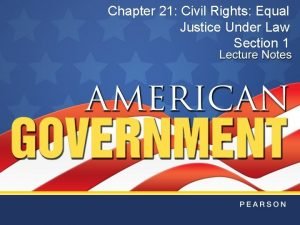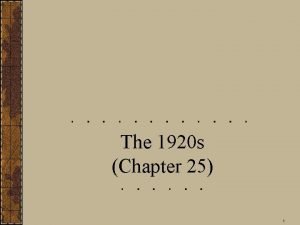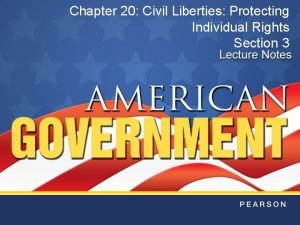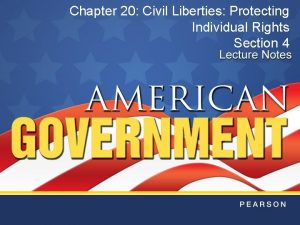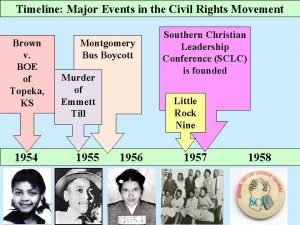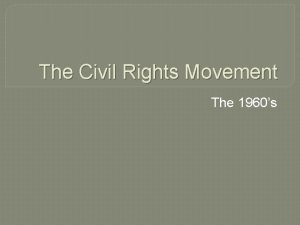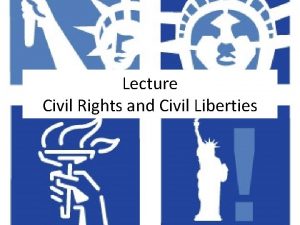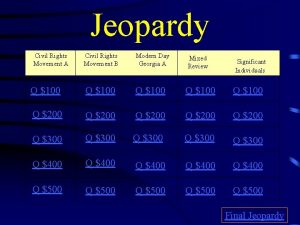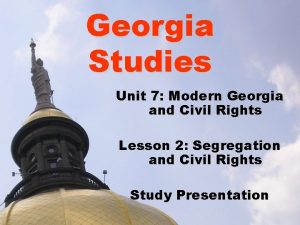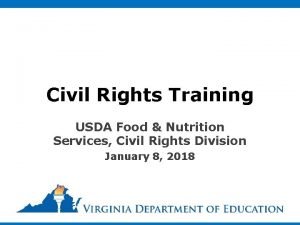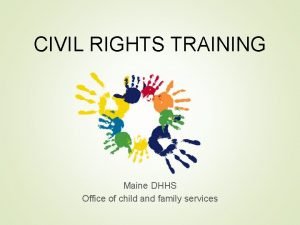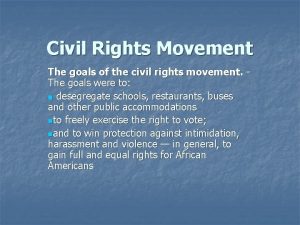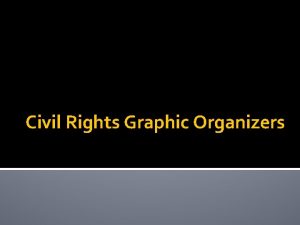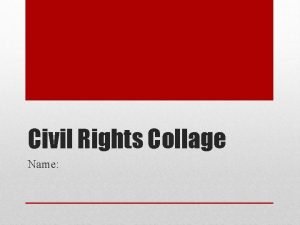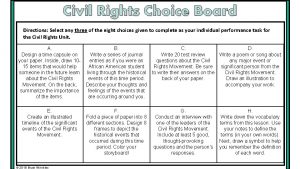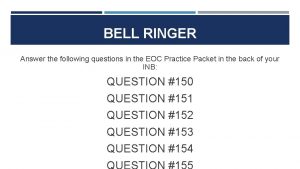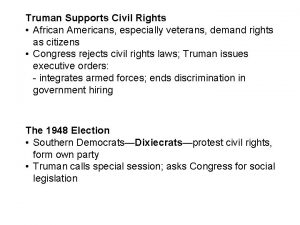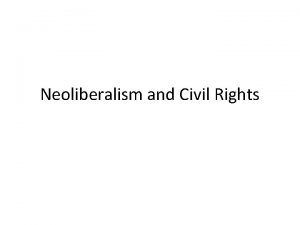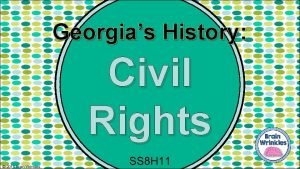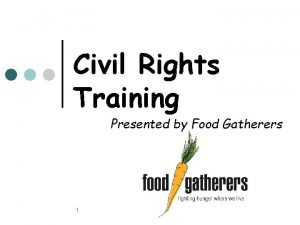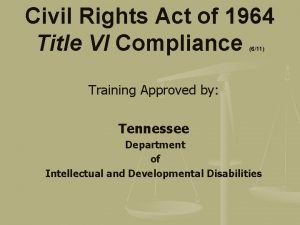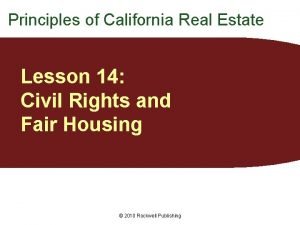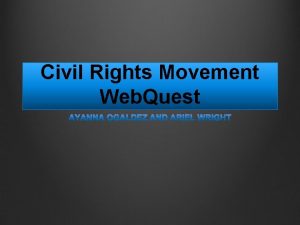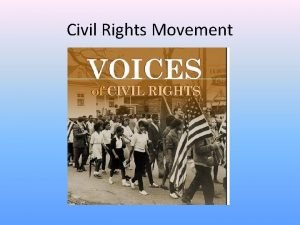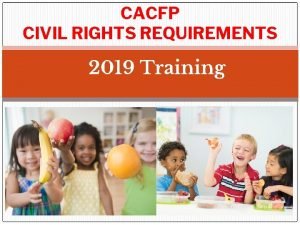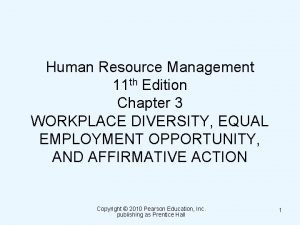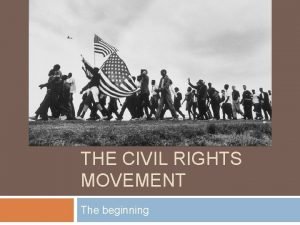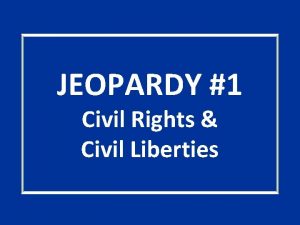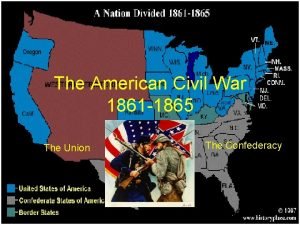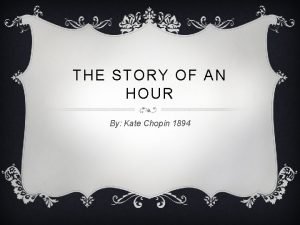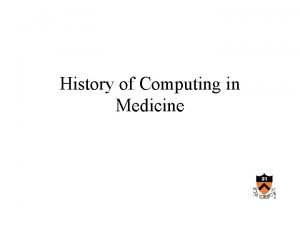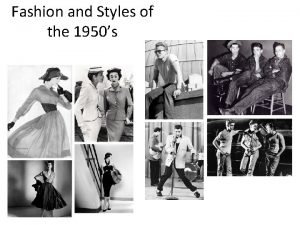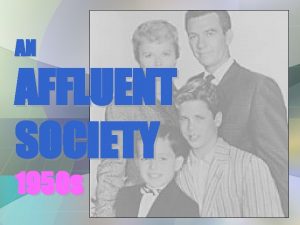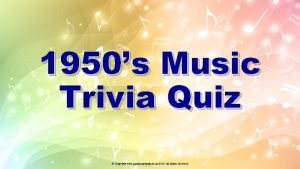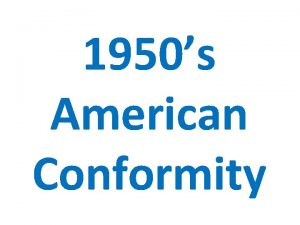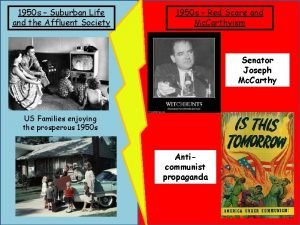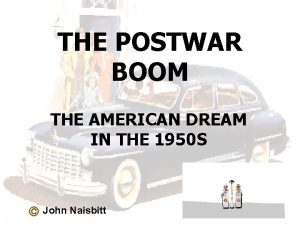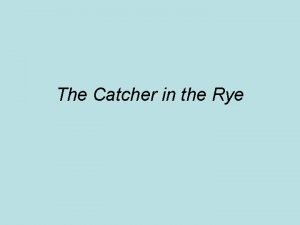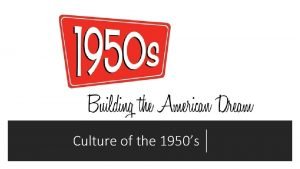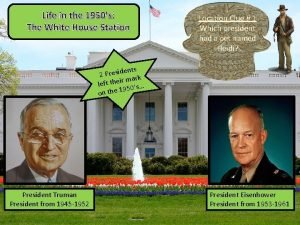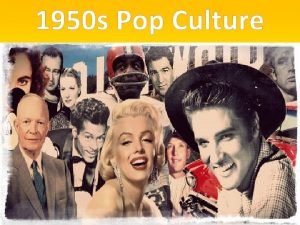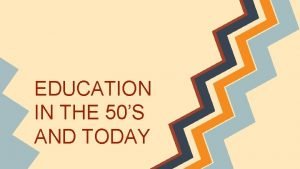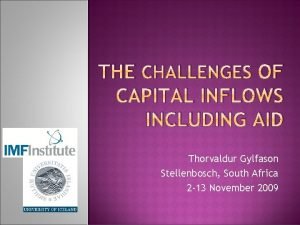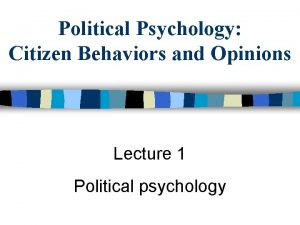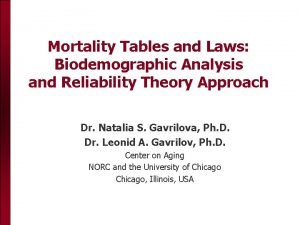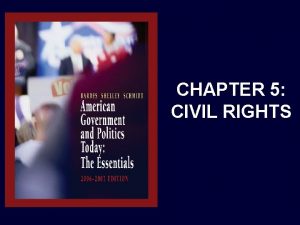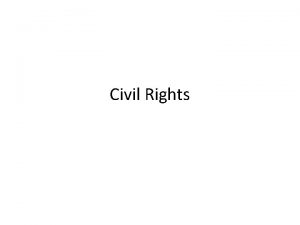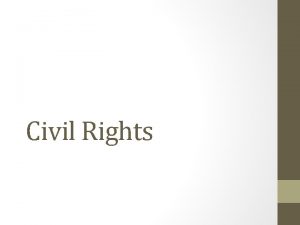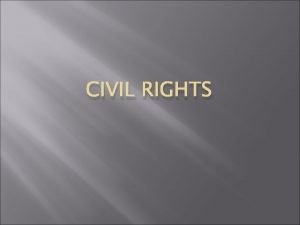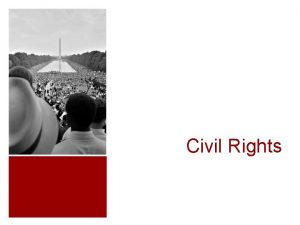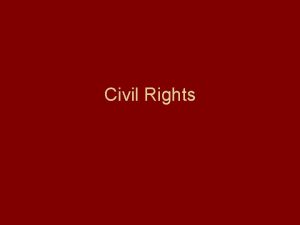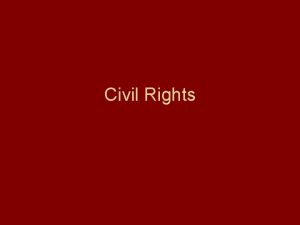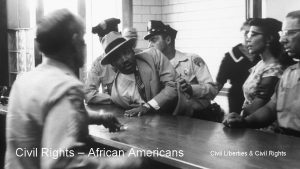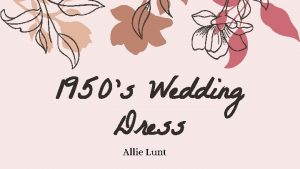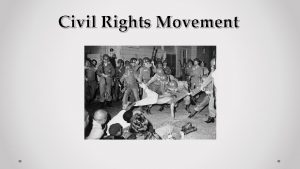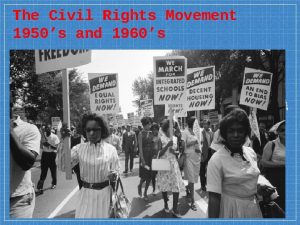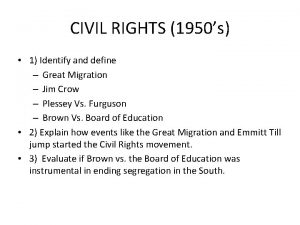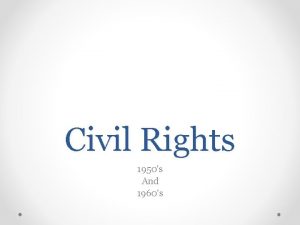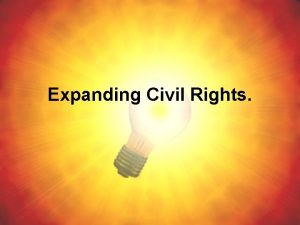CIVIL RIGHTS Chapter 21 During the 1950s a





















































































- Slides: 85

CIVIL RIGHTS Chapter 21

During the 1950’s, a civil rights movement began. This was a movement by blacks to gain greater equality in American society.

WWII had given African Americans a taste of equality & respectability. When the war ended, many African Americans were more determined than ever to improve their status.

Beginning in 1938, a team of lawyers led by Thurgood Marshall began arguing several cases before the Supreme Court. Their biggest victory came in the ’ 54 case of Brown v. Board of Education of Topeka, Kansas.

In Brown v. Board of Education…. . Supreme Court ruled that separate schools for whites & blacks were unequal…. and thus unconstitutional.

George E. C. Hayes, Thurgood Marshall, and James Nabrit, congratulating each other, following Supreme Court decision declaring segregation unconstitutional

Some Southern communities refused to accept the Brown decision. In 1955, the Supreme Court handed down a 2 nd Brown ruling. It ordered schools to desegregate more quickly.

The school desegregation issue reached a crisis in 1957 in Little Rock, Arkansas. The state’s governor, Orval Faubus, refused to let 9 black students attend Little Rock’s Central High School.


President Eisenhower sent in federal troops to allow the students to enter the school. U. S. Army troops from the 101 st Airborne Division disperse a crowd in front of Little Rock's Central High School

The Little Rock Nine and Daisy Bates

Blacks also battled discrimination on city buses. In Montgomery, Alabama, a local law required that blacks give up their bus seats to whites.

In December 1955, Montgomery resident Rosa Parks refused to give her seat to a white man. She was arrested.

Rosa Parks' Police mugshot

After her arrest, African Americans in Montgomery organized a yearlong boycott of the city’s bus system. The bus on which Rosa Parks rode is now a museum exhibit

The protesters looked for a person to lead the bus boycott. They chose Dr. Martin Luther King, Jr. , the pastor of a Baptist Church.

Martin Luther King Jr. , after his arrest in February of 1956, at the age of 27. He had been arrested during the Montgomery Bus Boycott. The mug shot was found in July, 2004, during the cleaning out of a storage room at the Montgomery County Sheriff's Department. Someone had written "DEAD" twice on the picture, as well as 4 -4 -68, the date King was killed, though it is not known who wrote it.

Martin Luther King Jr. preached nonviolent resistance. Outside of the Southern Christian Leadership Conference Headquarters. The Southern Christian Leadership Conference Logo. King joined w/other ministers & civil rights leaders in 1957. They formed the Southern Christian Leadership Conference (SCLC).

By 1960, another influential civil rights group emerged. The Student Nonviolent Coordinating Committee (SNCC) was formed mostly by college students. Members of this group felt that change for African Americans was occurring too slowly.

One protest strategy that SNCC (“snick”) used was the sit-in. During a sit-in, blacks sat at whitesonly lunch counters. They refused to leave until they were serve.

In February 1960, African-American students staged a sit-in at a lunch counter at a Woolworth’s store in Greensboro, N. C. The students sat there as whites hit them & poured food over their heads.

The "Greensboro Four" waiting to be served at Woolworth's

Several downtown lunch counters simply closed service to all rather than deal with the issue of integrating lunch counters during the sit-ins.


By late 1960, students had desegregated lunch counters in 48 cities in 11 states.

The Triumphs of a Crusade Section 2

Freedom Riders were protesters who rode buses w/the goal of integrating buses & bus stations. In 1961, a bus of Freedom Riders was attacked in Anniston, Alabama, where a white mob burned the bus. Another instance occurred when a group of Nashville students rode into Birmingham, Alabama, where they were beaten.

Ku Klux Klansmen beat black bystander George Webb in the Birmingham Trailways bus station, May 14, 1961. The man with his back to the camera (center right) is FBI undercover agent Gary Thomas Rowe. Oxford University Press

Jim Peck, seated, talks with a Justice Dept. representative and Ben Cox on the "freedom plane" to New Orleans, May 15, 1961. Photo by Theodore Gaffney. Oxford University Press

John Lewis and James Zwerg, two Freedom Riders beaten up by a white mob in Montgomery, Alabama.



Attorney General Robert Kennedy ordered a reluctant bus company to continue to carry the freedom riders. When freedom riders were attacked in Montgomery, Alabama, President Kennedy sent 400 U. S. marshals to protect the freedom riders. The Interstate Commerce Commission banned segregation in all travel facilities including waiting rooms, rest rooms, & lunch counters.

Civil rights workers soon turned their attention to integrating Southern schools. In Sept. 1962, a federal court allowed James Meredith to attend the all-white University of Mississippi. However, Mississippi’s governor refused to admit him.

James Meredith addresses the rally in Jackson, Mississippi.

The Kennedy administration sent in U. S. marshals. James Meredith heads to class, flanked by federal officials. Photo: courtesy Library of Congress They forced the governor to let in Meredith.

Another confrontation occurred in 1963 in Birmingham, Alabama when MLK & other civil rights leaders tried to desegregate the city. Police attacked activists with dogs & water hoses.


Many Americans witnessed the attacks on television. They were outraged by what they saw. Eventually, Birmingham officials gave in. They agreed to end segregation in the city.

The growing civil rights movement impressed President Kennedy. He became convinced that the nation needed a new civil rights law. President Kennedy meets the leaders of the civil rights movement Kennedy called on Congress to pass a sweeping civil rights bill.

President Kennedy’s civil rights bill outlawed discrimination based on race, religion, national origin, & gender. Civil rights leaders staged a massive march on Washington, D. C.

On August 28, 1963, more than 250, 000 blacks & whites marched into the nation’s capital. There they demanded the immediate passage of the bill

Dr. Martin Luther King Jr. , spoke to the crowd. He called for peace & racial harmony in his now famous “I Have a Dream” speech.

Several months later, JFK was assassinated. Lyndon Johnson became president. President Lyndon B. Johnson meets with Civil Rights leaders He won passage in Congress of Kennedy’s Civil Rights Act of 1964.

Signing of the 1964 Civil Rights Act Credit: LBJ Library photo by Cecil Stoughton

Civil rights activists next worked to gain voting rights for African Americans in the South. A group of student volunteers waiting for buses to take them to Mississippi (1964) The voting project became known as Freedom Summer.

The workers focused their efforts on Mississippi police departments beefed up their forces in preparation for the Summer Project, which state politicians called an invasion by "outside agitators. " They hoped to influence Congress to pass a voting rights act.


Meanwhile, civil rights activists challenged Mississippi’s political structure. MFDP 5 th Congressional District caucus. Local leaders (left to right) Marie Blalock, Peggy Jean Connor, Vassie Patton At the 1964 Democratic National Convention, SNCC organized the Mississippi Freedom Democratic Party (MFDP).

The new party hoped to unseat Mississippi’s regular party delegates at the convention. Atlantic City boardwalk, August 1964. Vigil in support of the MFDP challenge to the Democratic Convention.

Civil rights activist Fannie Lou Hamer spoke for the MFDP at the convention. The Democratic Party offered only 2 of Mississippi’s 68 seats to MFDP members. MFDP delegates occupying the Mississippi seats, Democratic Convention, Atlantic City, 1964

In 1965, civil rights workers attempted a voting project in Selma, Alabama. They were met with violent resistance. .

Police wait for marchers to come across the Edmund Pettus Bridge


As a result, MLK led a massive 2 nd march through Alabama.


President Johnson responded by asking Congress to pass a new voting rights act. Signing of the Voting Rights Act Congress passed the Voting Rights Act of 1965. The law eliminated state laws that had prevented African Americans from voting.

Signing Ceremony for the Voting Rights Act Credit: LBJ Library photo by Frank Wolfe

Challenges & Changes in the Movement Section 3

The biggest problem in the North was de facto segregation… segregation that exists by practice & custom. De jure segregation De facto segregation can be harder to fight than de jure segregation… segregation by law. Eliminating de facto segregation requires changing people’s attitudes rather than repealing laws.

By the mid 1960’s, many black Americans in the North lived in decaying urban slums. The terrible conditions in Northern cities angered many African Americans. This anger led to many episodes of violence.

During the 1960’s, new African –American leaders emerged. They called for more aggressive tactics in fighting racism. One such leader was Malcolm X. Malcolm preached the views of Elijah Muhammad…the head of the Nation of Islam, or the Black Muslims.

Malcolm declared that whites were responsible for blacks’ misery. Malcolm X holding an M 1 Carbine and pulling back the curtains to peer out of a window. This photograph is a popular image on Tshirts and often appears with the slogan "By any means necessary. " He also urged African Americans to fight back when attacked.

Malcolm with Elijah Muhammad at Savior's Day

Eventually, Malcolm changed his policy regarding violence. He urged African Americans to use peaceful means…especially voting…to win equality. Group around body of Malcolm X In February 1965, he was assassinated.


Another new black leader was Stokely Carmichael. He introduced the notion of Black Power. This movement encouraged African American pride & leadership. The classic image of the Black Power Movement

In 1966, some African Americans formed a political party called the Black Panthers. Logo of the Black Panther Party The party was created to fight police brutality. They urged violent resistance against whites. Many whites & moderate African Americans feared the group.

Black Panthers Bobby Seale (left) and Huey Newton (right) on cover of the party's newspaper, dated November 1, 1969

In April 1968, a gunman shot & killed Martin Luther King Jr. in Memphis, Tennessee.


The assassin of King was James Earl Ray, a chronic criminal and drifter. Ray was arrested and sentenced to life in prison. On one occasion he escaped but was recaptured. Near the end of his life, he made claims of innocence and knowledge of a conspiracy to murder Dr. King


The Lorraine Motel, where Rev. King was assassinated, now the site of the National Civil Rights Museum

Many leaders called for peace. But anger over King’s death led many African Americans to riot. Cities across the nation erupted in violence.

A bullet claimed the life of yet another leader in 1968. Senator Kennedy mortally wounded with rosary in hands In June, a man shot & killed Senator Robert Kennedy.

Kennedy was a strong supporter of civil rights. The assassin was a Jordanian immigrant. Sirhan in custody He allegedly was angry about Kennedy’s support of Israel. Kennedy had been seeking the Democratic nomination for president when he was killed.

Shortly after taking office, President Johnson formed a group known as the Kerner Commission. The commission’s job was to study the cause of urban violence. In March 1968, the commission issued its report. It named 1 main cause for violence in the cities: Racism.

What, then, did the civil rights movement achieve? The movement claimed many triumphs. It led to the passage of important civil rights acts. This included the Civil Rights Act of 1968. This law banned discrimination in housing.

President Johnson signing the Civil Rights Act of 1968

The movement had also led to the banning of segregation in education, transportation, & employment. It had also helped African Americans gain their full voting rights.

Yet many problems remained. Whites continued to flee the cities. Throughout the years, much of the progress in school integration reversed. African Americans continued to face high unemployment.

The government continued steps to help African Americans…& other disadvantaged groups. During the late 1960’s, federal officials began to promote affirmative action. Affirmative action programs involve making special efforts to hire or enroll minorities.

The End

COMING NEXT…. THE VIETNAM WAR YEARS Chapter 22
 Civil rights webquest
Civil rights webquest Chapter 21 civil rights equal justice under law
Chapter 21 civil rights equal justice under law Chapter 20 civil liberties protecting individual rights
Chapter 20 civil liberties protecting individual rights Chapter 14 postwar prosperity and civil rights
Chapter 14 postwar prosperity and civil rights Postwar prosperity and civil rights
Postwar prosperity and civil rights Chapter 20 civil liberties protecting individual rights
Chapter 20 civil liberties protecting individual rights Chapter 20 civil liberties protecting individual rights
Chapter 20 civil liberties protecting individual rights Civil rights timeline of events
Civil rights timeline of events Civil rights sitins
Civil rights sitins Mother of the modern day civil rights movement
Mother of the modern day civil rights movement Right to die
Right to die Civil rights movement jeopardy
Civil rights movement jeopardy Unit 7: modern ga and civil rights
Unit 7: modern ga and civil rights Usda civil rights training
Usda civil rights training Civil rights training certificate
Civil rights training certificate Civil rights movement goal
Civil rights movement goal Civil rights in child nutrition programs
Civil rights in child nutrition programs Civil rights graphic organizer
Civil rights graphic organizer Civil rights collage
Civil rights collage Civil rights choice board
Civil rights choice board Civil rights bell ringers
Civil rights bell ringers Truman supports civil rights
Truman supports civil rights Characteristics of civil rights
Characteristics of civil rights Civil rights cloze notes 1
Civil rights cloze notes 1 Civil rights cloze notes 1
Civil rights cloze notes 1 Federally protected classes
Federally protected classes Title vi of the civil rights act of 1964
Title vi of the civil rights act of 1964 Civil rights in child nutrition programs
Civil rights in child nutrition programs Civil rights movement vocabulary
Civil rights movement vocabulary Unruh civil rights act real estate
Unruh civil rights act real estate Civil rights movement webquest
Civil rights movement webquest Civil rights movment
Civil rights movment Cacfp civil rights
Cacfp civil rights Title vii of the civil rights act
Title vii of the civil rights act Title vii of the civil rights act
Title vii of the civil rights act The civil rights movement
The civil rights movement Civil rights jeopardy
Civil rights jeopardy Civil rights movement essential questions
Civil rights movement essential questions What did sncc accomplish and how
What did sncc accomplish and how Positive vs negative rights
Positive vs negative rights Littoral and riparian rights
Littoral and riparian rights Legal rights and moral rights
Legal rights and moral rights Legal rights vs moral rights
Legal rights vs moral rights Positive vs negative rights
Positive vs negative rights Negative rights
Negative rights Negative rights vs positive rights
Negative rights vs positive rights Positive rights and negative rights
Positive rights and negative rights Anaconda plan civil war
Anaconda plan civil war Why does richards rush to tell mrs. mallard the news
Why does richards rush to tell mrs. mallard the news 1950s computers
1950s computers 1950s fashin
1950s fashin Concept cars of the 1950s
Concept cars of the 1950s The affluent society 1950s
The affluent society 1950s 50s music trivia questions and answers
50s music trivia questions and answers 1950s conformity examples
1950s conformity examples Suburban life 1950s
Suburban life 1950s 1950s conformity and counterculture
1950s conformity and counterculture Ron offutt house
Ron offutt house Catcher in the rye 1950s culture
Catcher in the rye 1950s culture 1950s pop culture
1950s pop culture Mass media in the 1950s
Mass media in the 1950s White house 1950s
White house 1950s Beat writers 1950s
Beat writers 1950s 1950s beatnik fashion
1950s beatnik fashion Education in the 50s
Education in the 50s Color tv started
Color tv started Trends of 1950s
Trends of 1950s Trends of 1950s
Trends of 1950s Leonid gavrilov
Leonid gavrilov Trends of 1950s
Trends of 1950s Language
Language Red scare 1950s
Red scare 1950s Hình ảnh bộ gõ cơ thể búng tay
Hình ảnh bộ gõ cơ thể búng tay Frameset trong html5
Frameset trong html5 Bổ thể
Bổ thể Tỉ lệ cơ thể trẻ em
Tỉ lệ cơ thể trẻ em Voi kéo gỗ như thế nào
Voi kéo gỗ như thế nào Tư thế worm breton là gì
Tư thế worm breton là gì Hát lên người ơi
Hát lên người ơi Môn thể thao bắt đầu bằng chữ f
Môn thể thao bắt đầu bằng chữ f Thế nào là hệ số cao nhất
Thế nào là hệ số cao nhất Các châu lục và đại dương trên thế giới
Các châu lục và đại dương trên thế giới Công thức tính thế năng
Công thức tính thế năng Trời xanh đây là của chúng ta thể thơ
Trời xanh đây là của chúng ta thể thơ Mật thư tọa độ 5x5
Mật thư tọa độ 5x5 101012 bằng
101012 bằng

